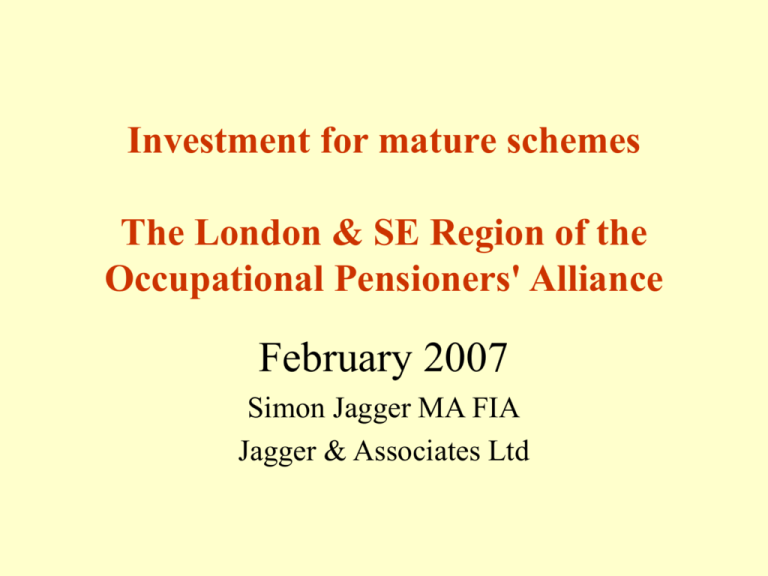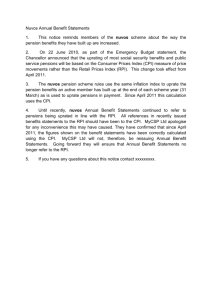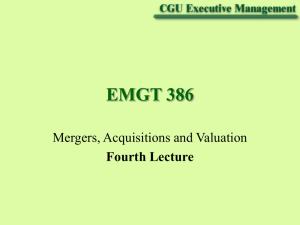here - The Occupational Pensioners' Alliance
advertisement

Investment for mature schemes The London & SE Region of the Occupational Pensioners' Alliance February 2007 Simon Jagger MA FIA Jagger & Associates Ltd Structure of a typical mature scheme • Usually closed to new members and to ongoing accrual – i.e. deferreds and pensioners only • “Active” deferred members may have salary linked benefits • Need to consider age-by-age reserves profile, and associated matching asset allocations - duration of liabilities will influence strategy • Examine future cashflow pattern • [Sample charts follow later] • Consider how any strategy will evolve over time, and at what speed, plus materiality • Compare size of Scheme to financial size of sponsoring employers - Trustee concerns over employer covenant General Considerations • Benefits go up broadly in line with RPI • So do payments on index-linked Government Stocks • So I-L gilts are a natural “match for these liabilities BUT – the match is not perfect …. • Inflation can (in theory) be negative (unlike pension increases) • Pension increases typically have a ceiling • Index-linked gilts are not “long” enough, and too sparse at longer dates • Too many pension schemes want them, therefore very expensive! • Not a match for salary increases Gilts and Corporate Bonds 13 12 11 10 9 8 7 % 6 5 4 3 2 1 0 Dec-85 Jun-88 Dec-90 Jun-93 Dec-95 Jun-98 Long bond yield Sources: Dec-00 Jun-03 Dec-05 ILG RY Financial Times, Barclays Capital 400 350 300 250 200 150 100 50 0 -50 Dec-90 Dec-92 Dec-94 Non-Gilt Dec-96 AAA Dec-98 AA Dec-00 A Dec-02 BBB Dec-04 Example Cashflow Projection Cashflow (£k) 1,800 1,600 1,400 1,200 1,000 800 600 400 200 2005 2015 2025 2035 2045 2055 2065 Tim e Active Deferred Pensioner Total • A typical closed scheme pattern • Scheme Actuary will normally update data as part of valuation NB – a generic scheme Another cashflow example, this time with ILG “matching” 180 160 140 120 100 80 60 40 20 0 2007 2017 2027 2037 Liability (£m) 2047 2057 2067 ILG • Spikes are the years when the 11 ILGs mature • Not much of a cashflow fit, so you have to realise a lot of capital as you go along NB – a generic scheme Cashflow Projections Assumptions • Pension increases (RPI?) • Salary increases where relevant (RPI+2%?) • Mortality – much more a subject of debate now Note that investment returns do not figure at this stage % of liability Example Liability Profile 10% 9% 8% 7% 6% 5% 4% 3% 2% 1% 0% 23 33 43 53 63 Age next at April 2004 Active NB – a generic scheme Deferred Pensioner 73 The Problem Cashflows have to be met from: • Investment proceeds, and/or • Employer contributions More of one means less from the other • Can work out “required yield” from current fund (which is where the investment return starts to enter the situation) • Often very sensitive Example Fund Projection 45,000 40,000 Fund size (£k) 35,000 30,000 25,000 20,000 15,000 10,000 5,000 2005 2010 2015 2020 2025 2030 2035 2040 2045 2050 2055 2060 Year 5% 6.27% • A mature scheme, almost at the contracting stage, and with a sizeable FRS17 deficit • Implied required investment return NB – a generic scheme The XYZ Pension Scheme • If assets are sufficient on basis of gilt yields, why risk failure by investing elsewhere? But there is still exposure to mortality risk. • Very few schemes are in the luxury of having this as an option. The XYZ Pension Scheme • Most schemes rely on ongoing contributions from the employer • What investment return was assumed in calculating the contributions? • Does this force the trustees to look for higher returns? • If not, do the trustees want to “help” the employer? (e.g. charities or non-profit employers) The XYZ Pension Scheme What are the options? • • • • • • • Corporate Bonds High Yield (sometimes still called junk bonds) Property UK Equities Overseas Equities Private Equity Hedge Funds Example Risk-Return Profile 6 OS equity UK equity 5 Real Return (% p.a.) Property HY 4 Current 3 OS bonds 2 1 UK bonds ILG Cash 0 0 2 4 6 8 Risk (% p.a.) NB – a generic scheme 10 12 14 Equity Risk Premium 7% 6% 5% 4% 3% 2% 1% 0% -1% -2% Feb-97 Feb-99 Feb-01 UK prem US prem Feb-03 Feb-05 trigger • Based on market and earnings levels, plus bond yields • Want the result to be well above the “trigger” to justify holding equities Commercial Property 40 30 % Return 20 10 - -10 -20 73 Sources: 78 83 88 93 98 03 IPD, UBS • Long run of strong returns – too good to be true? • Still a good income generator for many schemes “Period to deficit payoff” analysis – allowing for investment risk 20% 18% 16% 14% 12% 10% 8% 6% 4% 2% 0% 0 5 10 15 20 25 • Little chance of eliminating deficit in the early years • Initial peak is around the term used by the actuary, assuming no investment risk • Material risk that the deficit is still outstanding after 25 years Conclusion • You need to understand many things for a mature scheme before you can begin to assess what the investment strategy should be! These include: • The shape of a scheme, and how it is expected to evolve, both in liability profile and cashflow terms • The employer covenant, and scope for support via direct contributions or other methods • Make sure you focus on material aspects first!







